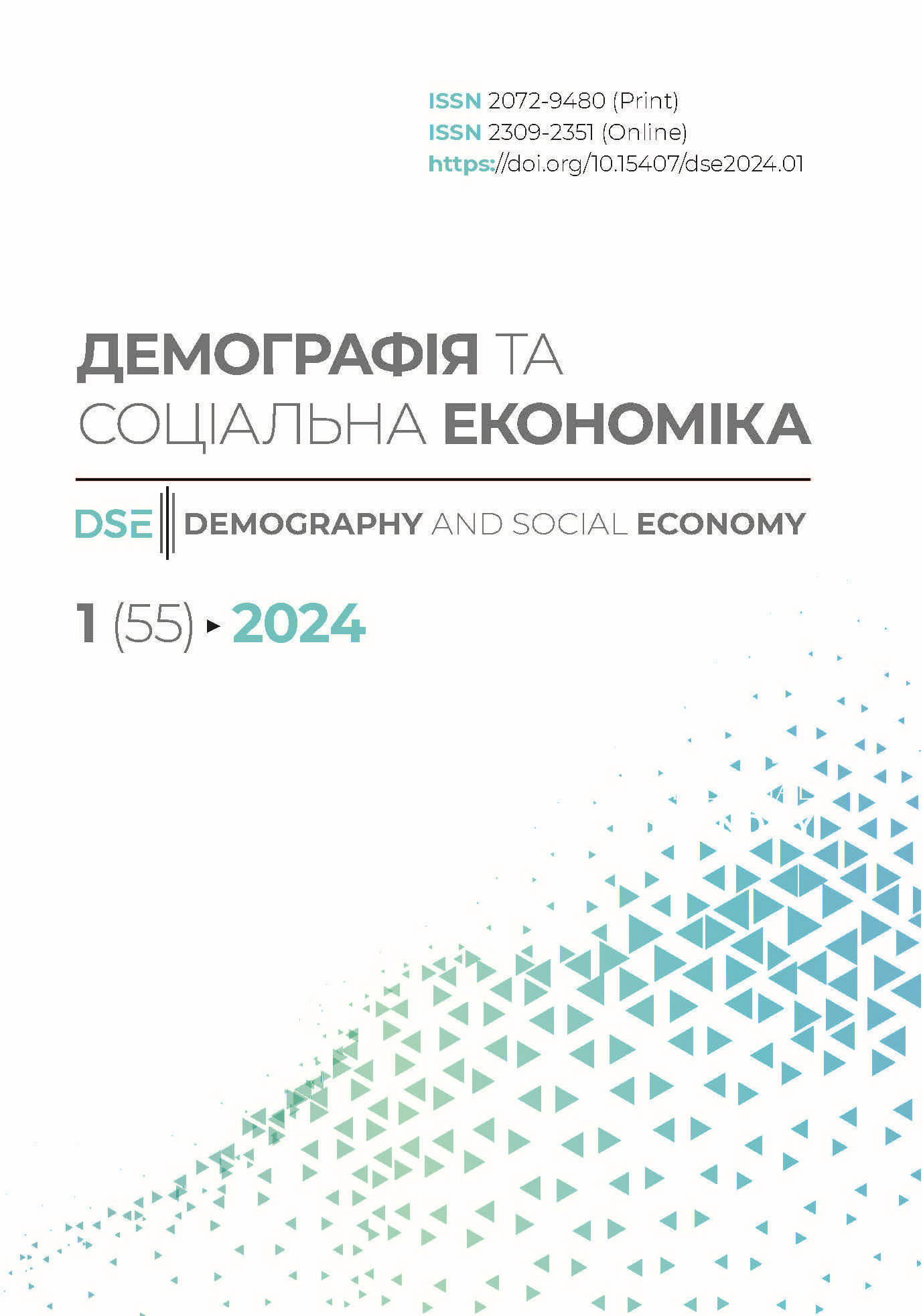IMPACT OF «RURAL» BEHAVIORAL STRATEGIES OF THE POPULATION OF UKRAINE ON QUALITY OF LIFE IN TIMES OF WAR
DOI:
https://doi.org/10.15407/dse2024.01.078Keywords:
population behavioral strategies, «rural» behavioral characteristics, quality of life, poverty by absolute criterion for costs below the actual subsistence minimum, impact of war on quality of lifeAbstract
The purpose of the article is to analyse and understand how «rural» behavioural aspects of the Ukrainian population influence the perception and adaptation to the conditions of armed conflict. The novelty of the study lies in the analysis of those rural behavioural aspects that are common to the entire population and may impact adaptation strategies and the improvement of quality of life during military events. In the context of modern conflicts and war scenarios, the study of population behaviour and its impact on the resilience of quality of life becomes particularly significant. Military conflicts not only threaten the safety and stability of society but also sharply increase the importance of understanding population behavioural aspects in the conditions of armed conflict and their impact on the quality of life. The examination of population behaviour during an extreme period of armed conflict potentially provides answers to how effectively the Ukrainian population can adapt to economic difficulties and overcome them.
For the investigation of the impact of «rural» behavioural aspects on the quality of life of the population in Ukraine, a combination of specialized and general scientific methods was employed. These include the monographic method, bibliometrics, and content analysis. Additionally, forecasting and modelling methods were utilized to predict the impact of fullscale military actions on poverty, a key indicator of quality of life. After the conducted research, it can be noted that in the conditions of a full-scale invasion by Russian forces, the «rural» behavioural characteristics of Ukrainians exhibit numerous advantages, arising from the close interaction between rural and urban existence. It is demonstrated that a potentially significant portion of the country’s population, particularly those of rural origin, possesses skills in land management. The presence of relatives in villages and small towns, who have large living spaces and substantial land plots, enabled the acceptance of many forcibly displaced individuals during the war. The study confirms that behavioural traits such as the tradition of stockpiling food supplies, maintaining habitable housing conditions in rural areas, and the existence of close familial and social ties have significantly mitigated the impact of the war on the population.
REFERENCES
- Kahneman, D. & Tversky, A. (1979). Prospect Theory: An Analysis of Decision under Risk. Econometrica, 47 (2), 263—291. https://doi.org/10.2307/1914185
- Shafir, E., & Mullainathan, S. (2011). Scarcity: Why Having Too Little Means So Much. Times Books.
- Thaler, R., & Sunstein, C. (2009). Nudge: Improving Decisions About Health, Wealth, and Happiness. Penguin Books.
- Di Crosta, A., Ceccato, I., Marchetti, D., La Malva, P., Maiella, R., & Cannito, L. et al. (2021). Psychological factors and consumer behavior during the COVID-19 pandemic. PLOS ONE, 16(8). https://doi.org/10.1371/journal.pone.0256095
- Josephson, A., Kilic, T., & Michler, J. D. (2021). Socioeconomic impacts of COVID-19 in low-income countries. Nature Human Behaviour, 5(5), 557—565. https://doi.org/10.1038/ s41562-021-01096-7
- Kizyma, T., Bulavynets, V., & Kizyma, A. (2022). Financial behavior of households in the context of the development of behavioral finance. Economic Analysis, 32(4), 152—164. https://doi.org/10.35774/econa2022.04.152
- Lintsova, N. (2021). Consumption in the style of life of villages.
- Yermakova, Y. (2022). Survive and win: how the purchasing behavior of Ukrainians during the war has changed. RAU and Nielseniq research. Association of retailers of Ukraine. https://rau.ua/novyni/povedinka-ukrainciv-nielseniq/ [in Ukrainian].
- Kogatko, Y. (2012). Changes in the standard of living of the population of the village and the city in 1980-2010. Economic and social geography, 64, 77—87. http://irbis-nbuv. gov.ua/cgi-bin/irbis_nbuv/cgiirbis_64.exe?C21COM=2&I21DBN=UJRN&P21 DBN=UJRN&IMAGE_FILE_DOWNLOAD=1&Image_file_name=PDF/ esg_2012_64_11.pdf [in Ukrainian].
- Costs and resources of households of Ukraine in 1999 (2000). State Statistics Service of Ukraine [in Ukrainian].
- Costs and resources of households of Ukraine in 2021 (2022). State Statistics Service of Ukraine. https://ukrstat.gov.ua/druk/publicat/kat_u/2022/zb/07/zb_vrd_21.pdf [in Ukrainian].
- Prishchepa, O. (2022). Over three thousand people have fled from the war to the Men’s community. susidy.city. https://susidy.city/articles/209975/u-menskij-gromadi-otrimalistatus-vnutrishno-pereselenih-osib-3225-osib [in Ukrainian].
- Distribution of the population by duration of residence at a place of residence and age (2001). State Committee of Statistics of Ukraine. http://2001.ukrcensus.gov.ua/results/ migration/migration_4/select_64?box=6.4W&rz=1_1&rz_b=2_1&k_ t=00&botton=cens_db2 [in Ukrainian].
- Migration movement of the population (2002—2021) (2022). Main Department of Statistics of Kyiv. http://kyiv.ukrstat.gov.ua/p.php3?c=3976&lang=1[in Ukrainian].
- Housing fund by regions in 2020 (2021). State Statistics Service of Ukraine. https://ukrstat. gov.ua/operativ/operativ2021/zf/zf_reg/zf_reg_20_ue.xls [in Ukrainian].
- Shcherban, O. (2021). Live for free: how Japan’s power stimulates the settlement of rural areas. Investory News. https://investory.news/pozhiti-bezoplatno-yak-vlada-yaponiistimulyuye-zaselennya-silskix-teritorij/ [in Ukrainian].
- Miroshnichenko, L. (2023). How many citizens left Kiev in the first days of the war and how displaced persons appreciated the standard of living in the capital. 44.ua. https:// www.44.ua/news/3556882/skilki-gromadan-zalisili-kiiv-v-persi-dni-vijni-ta-akpereselenci-ocinili-riven-zitta-u-stolici [in Ukrainian].
- Kobzin, D. et al. (2020). The needs of internally displaced persons. Kharkiv Institute of Social Research. https://rm.coe.int/survey-results/16809f43db [in Ukrainian].
- Shcherban, S., Chernusov, A., & Prashko, O. (2023). The position of internally displaced families with children, foster families and orphanages of family type in war conditions. SOS Children’s towns in Ukraine National Office and Youth Center. https://sos-ukraine.org/ wp-content/uploads/2023/02/rezultaty-doslidzhennya-dity-i-vijna-veresen-lystopad2022r.pdf [in Ukrainian].
- Cherenko, L., Shyshkin, V., Poliakova, S., & Kohatko, Y. et al. (2020). Housing conditions of the population: factors, current state and regulation policy. Ptoukha Institute for Demography and Social Studies of the NAS of Ukraine [in Ukrainian].
Downloads
Published
How to Cite
Issue
Section
License
Copyright (c) 2024 Юрій Когатько, Світлана Полякова

This work is licensed under a Creative Commons Attribution-NonCommercial-NoDerivatives 4.0 International License.


